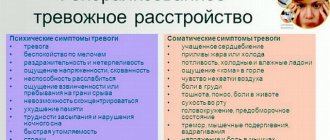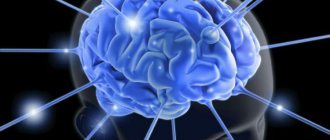: Reading time:
A psychotherapist with more than 14 years of experience, Krailina Irina Sergeevna, talks about effective methods of self-help for panic attacks, how they work, and the role of psychotherapy.
A person who has experienced a panic attack for the first time thinks that something extraordinary, terrible, catastrophic has happened to him.
Many of my patients, when they learn ways to control their emotions, thoughts and body, exclaim: “Oh, if only when this happened for the first time, someone told me that this is a disorder well known to doctors and psychologists, that it can be treated, and most importantly “They don’t die from it!”
After all, then, at the very beginning, there was one most terrible thought that covered everything in the world like a black cloud: “No one knows what’s wrong with me. I will die".
Therefore, a person tries to get first aid by calling an ambulance, or going to a therapist or cardiologist.
Many people try to fight this disorder on their own, looking for recommendations and advice on how to get rid of panic attacks. Usually on the Internet. There is a lot of information there, often it is scattered and contradictory.
Therefore, I will try to systematize information on recommendations and methods of self-help and talk about the benefits of psychotherapy.
For those who want to better understand the topic, the article contains “More details” blocks: you need to click/tap on them for additional information to appear. If your goal is to learn only about self-help techniques, just read the plain print.
Learn more about the mechanism of development and symptoms of panic attacks
Click on the title to read the text
A panic attack is an unpredictable attack of acute anxiety (panic) with bodily symptoms for which the autonomic nervous system (hereinafter referred to as the ANS) is responsible.
Scheme 1. How the autonomic nervous system (ANS) works
In an individual, these symptoms may be present in full or in part:
- heartbeat;
- rise in blood pressure;
- frequent shallow breathing;
- feeling of suffocation, tightness in the chest;
- goosebumps;
- cold extremities;
- dizziness;
- pallor;
- sweating;
- urge to defecate;
- nausea;
- trembling in hands.
These symptoms are a manifestation of autonomic crises (sympathetic-adrenal, vagoinsular or mixed). Often the attack is accompanied by fear of death, loss of control or madness, as well as a feeling of unreality of what is happening or change in one’s self.
Lasts for minutes and ends with the passage of a large amount of light-colored urine. The person feels broken and empty.
Vegetative crises can be a manifestation of certain somatic diseases (endocrine, cardiovascular system), can occur during pregnancy, taking certain medications, or occur as isolated episodes against the background of overwork or alcohol abuse.
When doctors have ruled out somatic pathology, but panic attacks recur, it is more correct to call it a panic disorder.
The reason for the recurrence of panic attacks is a special form of thinking (when anxious traits are combined with perfectionism, the need to control everything) plus instability of the autonomic nervous system (what doctors used to call vegetative-vascular dystonia).
After the first panic attack, a person is in constant anxious anticipation of its repetition. The slightest unpleasant sensation in the body or just a thought can trigger a cascade of somato-vegetative reactions that support and reinforce each other through the mechanism of a vicious circle and lead to panic.
To clearly explain how different self-help methods work, let’s consider a person as an integral system and highlight 4 components:
- the human body;
- his emotions;
- thoughts;
- the external environment with which it interacts.
These components interact with each other and influence each other.
An example of the interaction of body, emotions, thoughts and environment
Click on the title to read the text
For example, support from the environment, family, gives confidence (the thought) that help will be provided in any case. The level of anxiety (emotions) temporarily decreases and vegetative symptoms go away (body). The trouble is that environmental support does not completely eliminate panic disorder. She only supports the belief that one cannot cope with the disorder on one’s own.
Get to know the essence
As you know, a panic attack occurs groundlessly, without a real threat. She can find her carrier at home watching TV, at work or in her bed at night.
Its main driving factor is fear: death, hopelessness, fainting or having a heart attack. These are the thoughts that visit a panicker at the peak of an attack. They, in turn, trigger a pathological reaction in a circle until the psycho-emotional stress decreases. At the moment of such a cyclical process, there is a certainty that it will never end.
Where does this fear come from? It is provoked by a neurochemical imbalance: the amount of stress hormones (adrenaline, norepinephrine) prevails over serotonin, the hormone of happiness. This happens for various reasons: chronic stress, overwork, sedentary lifestyle, internal conflicts, bad habits, etc.
It is the feeling of fear, fueled by adrenaline, that causes a number of painful physiological symptoms. Among them are suffocation, chaotic fluttering of the heart muscle, profuse sweat, trembling, dizziness. All this is the result of a sharp narrowing of blood vessels and excess oxygen in the blood. Extreme fear drives a person to madness. He does not understand where he is, the world around him seems blurry and unclear.
The fight against a panic attack, as a malicious disturber of a person’s peace, begins when he realizes one fact: this condition is not a sign of a physical illness (if you do not have concomitant diseases). It is impossible to die from it, your heart will not stop, you will not suffocate from lack of air, you will not even faint.
Take and analyze your attack. When it ends, all symptoms go away and your body works smoothly again. The heart does not jump out of the chest, breathing is smooth, blood pressure is normal.
Surely you have already undergone all kinds of examinations, checked every organ, visited all the specialists. If their diagnosis is unanimous and confirms that you are physiologically healthy, shift the focus in the other direction: look for the problem in your head, in your mental state. Understand that a panic attack is the result of a mental imbalance, so it is not the body that needs to be treated, but the soul.
Signs of panic attacks
The term “panic attack” was introduced into medical use in 1980. Currently, it is included in the International Classification of Diseases; the patient is not able to independently cope with periodic attacks. He needs the help of a specialist; perhaps other pathologies will be identified during the examination.
A similar condition was previously considered within the framework of vegetative-vascular dystonia, but now this version is not relevant. The psychological factor is considered primary, and vegetative symptoms are considered secondary. Attacks are classified as neuroses, and the accompanying disorders at the physiological level are classified as autonomic dysfunction.
Panic paroxysms are common, especially common among residents of megacities. They experience frequent stress; the dynamic rhythm of life leaves no chance for relaxation and good sleep. The typical age for the first attack is between 25 and 45 years. In older people, panic paroxysms occur with less severe symptoms; they affect the emotional sphere to a greater extent.
An integral part of treatment
If you yourself are not able to improve your psycho-emotional background, seek help from a specialist. Psychotherapy is an integral part of the treatment of panic attacks. It is she who will allow you to get to the very essence, to understand why such shocks are happening to you. Along with “diagnosis” of the problem, it allows you to find ways to solve it.
The main method of psychotherapeutic treatment of panic disorder is cognitive behavioral therapy . It relieves anxiety and allows you to change the patient’s perception of his problem. The following techniques are used:
- self-observation diary;
- immersion in an alarming situation;
- meditation, muscle relaxation;
- proper breathing techniques.
The course of therapy is 10–20 sessions.
Other psychotherapeutic areas are also used in the treatment of panic attacks :
- Gestalt therapy;
- neurolinguistic programming;
- body-oriented therapy.
Hypnotherapy is in wide demand . To characterize it in a rough form, the doctor puts the patient into a trance and in this state instills in him certain instructions for getting rid of panic attacks, that is, he works with the person’s subconscious.
There is a softer form of hypnotherapy -
Ericksonian hypnosis .
In this case, the person is also in a state of trance, but retains the ability to communicate with a psychotherapist. The doctor does not give specific instructions to the patient, but provides him with the opportunity to understand his internal conflicts. Family therapy can also have positive results. It forces us to consider a person’s problem not only as his personal one, but also as a result of a lack of support from loved ones. The method teaches the patient’s relatives how to help him fight the disease and provide support.
Do not neglect psychotherapeutic methods. They radically change the patient’s thinking, attitude towards the situation, and lead him to self-knowledge. Such steps become key in getting rid of unreasonable anxiety.
Film actress Emma Stone first experienced a terrifying panic attack when she was 10 years old. She was visiting her friend. Just sitting down on the sofa, she was suddenly overcome with horror, it seemed to her that the house was on fire. She couldn’t get up from the sofa, sobbing, she called her mother to pick her up.
Since then, panic attacks have become a part of her life. She constantly forced her mother to tell her that everything was fine, nothing had happened, there was no danger. Persistent and long-term psychotherapy helped her get rid of these crises.
Mechanisms of panic symptoms
At the present stage, there are many hypotheses about the mechanisms of panic attacks, but they all boil down to disruptions in the processes underlying the reaction to stress.
Theories for panic cases:
- genetic theory;
Based on the idea that hereditary factors play a role in the risk of panic attack symptoms. The genes D4S413 and D9S271 are responsible for this.
- receptor theory;
The presence of a certain variant of the serotonin transporter protein (5HT LPR) leads to vulnerability to stress and correlates with the volume of brain gray matter in the amygdala and anterior cingulate gyrus;
- theory of human personality characteristics;
Symptoms of panic occur more often in people who have the following personality traits:
- Hypochondriacity;
- Demonstrativeness;
- I crave recognition;
- Great need to attract attention.
- psychoanalytic theory;
Its founder was Sigmund Freud. A person has natural needs for sex, freedom, aggression, if something affects his interests. Suppression of desires and interests under the pressure of family and social taboos leads to tension and internal conflict, which can develop into a panic attack. If strong experiences occur frequently, then a person may experience fear and a feeling of helplessness, which also provokes symptoms of panic.
- cognitive theory;
It consists of an incorrect interpretation of bodily sensations. Negative thinking contributes to incorrect internal experience, increased fear, which does not correspond to real dangers;
- social theory;
Modern life in a metropolis, pressure, stress, the need to conform to some status cause symptoms of panic not only in adults, but also in children and adolescents. Passing an exam, performing in competitions, fear of punishment, sexual violence cause symptoms of panic attacks;
- behavioral theory;
According to it, any external threatening event can take hold reflexively. For example, seeing a traffic accident causes your heart rate to increase and anxiety to arise. A repeated similar situation can again create an attack of anxiety and an acceleration of the pulse. In the future, a panic attack occurs without external causes;
- catecholamine theory;
Depending on the type of stress, the human body reacts with the release of adrenaline, a substance secreted by the adrenal cortex. It increases heart rate, increases blood pressure, and causes anxiety and fear.
Pharmacotherapy
It is impossible not to mention the drug treatment of panic attacks. There are many doubts about this method. Some patients say that stuffing themselves with chemistry is not a solution. Perhaps in some sense they are right. Without working on yourself, no one can give a 100% guarantee that the disease will not recur after completing the course of drug therapy.
But still, the positive role of drugs cannot be denied. They allow you to balance the emotional background, eliminate acute anxiety, relieve tension, normalize mood, provide an opportunity to relax, and improve sleep.
Typically, antidepressants and tranquilizers are prescribed to treat panic disorder.
Without awareness of your problem, of course, it is difficult to overcome the disorder forever. But pharmaceuticals will help you achieve this faster and easier.
Based on this, it is strongly recommended to combine psychotherapeutic and drug treatment. The combination of these methods is ideal for combating panic attacks.
The essence of auto-training
The founder of auto-training was Dr. I.G. Shultz. Later, after Schultz, many methods of conducting this therapy were described, including with the help of yoga and the teachings of Tibetan monks.
In 1932, Dr. Schultz, conducting hypnosis sessions with patients, noticed that some of them became much calmer and more relaxed during the procedure. Modern scientists have proven that self-hypnosis therapy for neuroses and overexcitation is a completely effective means for both treatment and prevention of such conditions.
The goal of auto-training for the patient is to reduce the memory of the disease, overcome their fears and achieve peace of mind.
Self-hypnosis has opened up a lot of opportunities for Eastern masters. With its help, they can control the work of their own body - slow down the pulse, stop and start the heart. The absolute record was set by one of the masters, who, having plugged his nostrils and ears, withdrew into himself for 30 days, while completely stopping all the vital processes of the body.
Modern man does not need such superpowers, but putting his thoughts in order, normalizing sleep and restoring the ability to enjoy life is quite possible with simple autodidactic exercises.
How to behave during an attack
The alarmist should be able to determine the onset of an attack. Muscle twitching appears, the legs become as if they are made of cotton, and coldness passes through the body. Shortness of breath appears, consciousness narrows, attention is fixed at one point.
When you feel the first warning signs, try to leave the room where you were attacked. It's best to go outside. You can take out your phone and call someone, distract yourself with information on the Internet.
If you cannot change your location, for example, this happened on a bus, try to switch your attention. The best way is to count any objects you find at hand:
- buttons and other clothing items;
- trees;
- machines, and you can use different variations. How many red or black cars have passed? How many cars move in one direction, and how many in the other;
- pillars;
- if you are in a crowd, count how many men and how many women you see;
- windows in houses.
Take one position. Stand, or better yet, sit down. Take a comfortable position. Lean on something solid and stable.
You can distract yourself by changing your bodily sensations. Pinch, lightly pull the hair, hit yourself with little force. Try to actively change your facial expressions: puff out and deflate your cheeks, pinch and spread your lips in a smile, close and open your eyes.
Perhaps, instead of a frozen pose, physical exercise will bring you out of horror. Squat, jump, you can run lightly, imitate jumping rope.
Another way to shift attention is to sing a song, out loud and loudly, or recite a verse also loudly and with expression. The text should be positive and not evoke gloomy emotions.
Actress Megan Fox discovered an interesting method of dealing with a panic attack. Usually they started on the plane. After she started playing Britney Spears songs and listening to them in headphones throughout the flight, the attacks stopped.
Be sure to control your breathing. You need to eliminate excess oxygen in the blood. To do this, try to breathe deeply. Take a deep, long breath and a loud, long exhale. Try to get all the air out of your lungs.
The most effective way to restore respiratory calm is to breathe into a bag or folded palms.
If a panic attack strikes you at home, take a contrast shower.
Of course, if the attack happened to a person for the first time, it will be difficult for him to control it. But, having learned how to deal with it, if it happens again, he will give it a worthy rebuff.
How to behave during the interictal period
Therapy for panic attacks during periods of calm includes several key points. The main thing is to get rid of stress, traumatic situations and internal tension.
It is very important to increase the body's ability to withstand stress. A set of measures will help with this .
- Learn to control your emotions and actions, take responsibility for them. To do this, analyze situations, your decisions, why you acted this way and not otherwise, what would have been better for you to do in this case. Write down your thoughts. If you have made wrong actions, review them and build a model of correct behavior. Now you know how to behave in a similar situation.
- Let more positive emotions into your life. Watch pleasant, funny films, do what you love more often, communicate with positive people. Try to be alone less.
- Stop making derogatory remarks about yourself. Praise yourself for your achievements, accept your shortcomings and work on them. Don't make comparisons between you and other people. Pay attention to yourself, look after yourself.
- Try not to mentally return to traumatic situations that happened to you in the past. To avoid reliving negative emotions. Try to remove all things that may remind you of this event.
- Find something you like. Direct your energy to creativity, not to dark thoughts.
Meditation will help you relax. It will relieve not only emotional tension, but also muscle tension. There are professional practices that require special training and knowledge of techniques.
At the everyday level, you can meditate by turning on relaxing music and taking a comfortable position. The best way to do this is to lie down. Close your eyes or focus on one object. Breathe deeply, evenly and mentally repeat the pre-prepared phrases: I am calm, my fear is receding, I have everything under control, and any other phrases adapted to your condition.
General recommendations
Maintaining the correct daily routine is an important point in the fight against nervous tension.
You need to create your daily routine in such a way that there is enough space for both work and rest. It is also important to alternate between work and rest.
Sound and healthy sleep is something you desperately need. Moreover, it should occur precisely at night and be at least 8 hours a day.
You will have to eliminate alcohol and other stimulating drinks : coffee, strong tea. They excite the nervous system and prevent you from relaxing. Instead, drink soothing herbal infusions based on mint, lemon balm, chamomile, and linden.
Review your diet . Leave only healthy food in it. More vegetables and fruits are beneficial.
Constantly repeat to yourself that sport is your assistant in the fight against relapses of panic attacks. This is an excellent method for relieving tension and releasing negative energy. It increases the level of endorphins in the blood and reduces the amount of stress hormones. In addition, sports will allow you to abstract from your problems. Believe me, a hundred jumping ropes will bring you out of the blues and save you from gloomy thoughts.
In addition, physical exercise improves blood circulation, eliminates muscle tension, and liberates the body. It gives self-confidence, activates thinking, teaches self-control, and, of course, tightens the figure, makes it slimmer, and the image more harmonious. You will receive enormous benefits from playing sports, improve your sense of self and self-perception, and free yourself from certain complexes.
Preparation for auto-training
Choosing the timing of training is an important aspect of auto-training. If you know your body well enough, then choose a time when it is most relaxed: immediately after sleep or in the evening after work. Comfortable selection of a time interval is the first step to success in treatment.
If it is difficult for you to immediately understand when it is more convenient to practice, then you can experiment. Try different options and choose the one that suits you best.
Organize your daily routine so that your training time does not change. The regularity of auto-training will allow the body to develop a habit over time, then each time it will independently relax by a certain time, so that the effect of therapy is maximum.
The patient's positive attitude and faith in the technique are also keys to healing. At this stage, the patient’s main task is to set a goal and go towards it. You should not miss a single workout - only systematically conducted sessions can help you achieve maximum results in the shortest possible time. It would be useful to study specialized literature.
The patient’s rethinking of his life and his priorities will be of great help in treatment. First of all, you should understand yourself, understand why you live. Surely something will have to change. But these changes will only benefit you.










